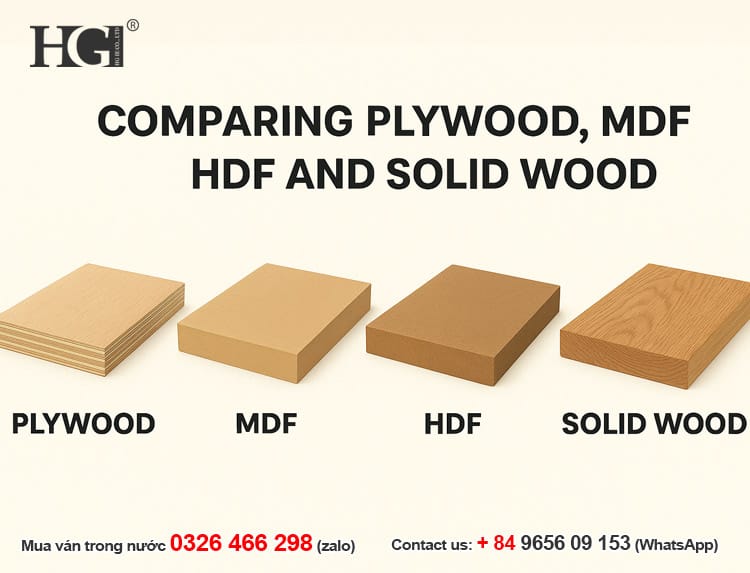When it comes to selecting wood materials for construction, furniture, or industrial production, people often compare Plywood, MDF, HDF, and Solid Wood. Each material has its own strengths and weaknesses, making it suitable for different applications.
In this article, we’ll provide a detailed comparison of Plywood, MDF, HDF, and Solid Wood to help you choose the best option for your project.

1. Plywood
Definition:
Plywood is an engineered wood product made from multiple layers of thin wood veneer bonded together with industrial adhesives.
Advantages:
- High durability and excellent load-bearing capacity.
- Better moisture and termite resistance compared to MDF and HDF.
- Widely used in furniture, packaging, construction formwork, and export products.
- 👉 View more Plywood products from HG Plywood:
Disadvantages:
- More expensive than MDF.
- Surface is not as smooth as HDF.
2. MDF (Medium Density Fiberboard)
Definition:
MDF is produced from wood fibers mixed with resin and pressed under high temperature and pressure.
Advantages:
- Very smooth surface, ideal for painting and veneering.
- Affordable price, cheaper than Plywood and Solid Wood.
- Suitable for low-cost, mass-produced furniture.
Disadvantages:
- Poor moisture resistance, prone to swelling and warping when exposed to water.
- Lower mechanical strength compared to Plywood and HDF.
3. HDF (High Density Fiberboard)
Definition:
HDF has a similar structure to MDF but is manufactured with a higher fiber density, making it stronger and more durable.
Advantages:
- Superior strength and hardness compared to MDF.
- Very smooth surface, easy to laminate or veneer.
- Less warping than MDF.
Disadvantages:
- More expensive than MDF.
- Moisture resistance is better than MDF but still weaker than Plywood.
4. Solid Wood
Definition:
Solid Wood is natural timber harvested directly from forests and processed into lumber for use.
Advantages:
- Beautiful natural wood grain with high aesthetic value.
- Extremely durable when properly treated.
- Long lifespan, easy to restore or refinish.
Disadvantages:
- High cost.
- Prone to warping and shrinking due to climate changes.
- Overexploitation negatively impacts the environment.
5. Comparison Table: Plywood vs MDF vs HDF vs Solid Wood
| Criteria | Plywood | MDF | HDF | Solid Wood |
|---|---|---|---|---|
| Durability | High | Medium | Higher than MDF | Very high |
| Moisture Resistance | Good | Poor | Average | Good (if treated) |
| Cost | Medium – High | Low | Medium | High |
| Surface | Fairly smooth | Very smooth | Very smooth | Natural, elegant grain |
| Applications | Furniture, construction, packaging | Budget furniture | Furniture, flooring | Premium furniture |
6. Which One Should You Choose?
- ✅ For durability, moisture resistance, and load-bearing capacity → choose Plywood.
- ✅ For budget-friendly and easy-to-process furniture → go with MDF.
- ✅ For a balance between cost and durability → HDF is the right choice.
- ✅ For luxury and premium aesthetics → nothing beats Solid Wood.
7. Conclusion
Each material—Plywood, MDF, HDF, and Solid Wood—has unique characteristics. The best choice depends on your project requirements, budget, and design preferences.
👉 If you are looking for high-quality Plywood that meets international export standards, contact HG Plywood today for expert consultation.
📞 Contact HG Plywood
- 🌐 Website: hgwoods.com
- 📱 Hotline/WhatsApp: (+84) 9656 09 153
- 📧 Email: hgplywood@gmail.com
- 🏭 Address: Dinh Xuyen, Gia Lam, Hanoi, Vietnam

Leave a Reply